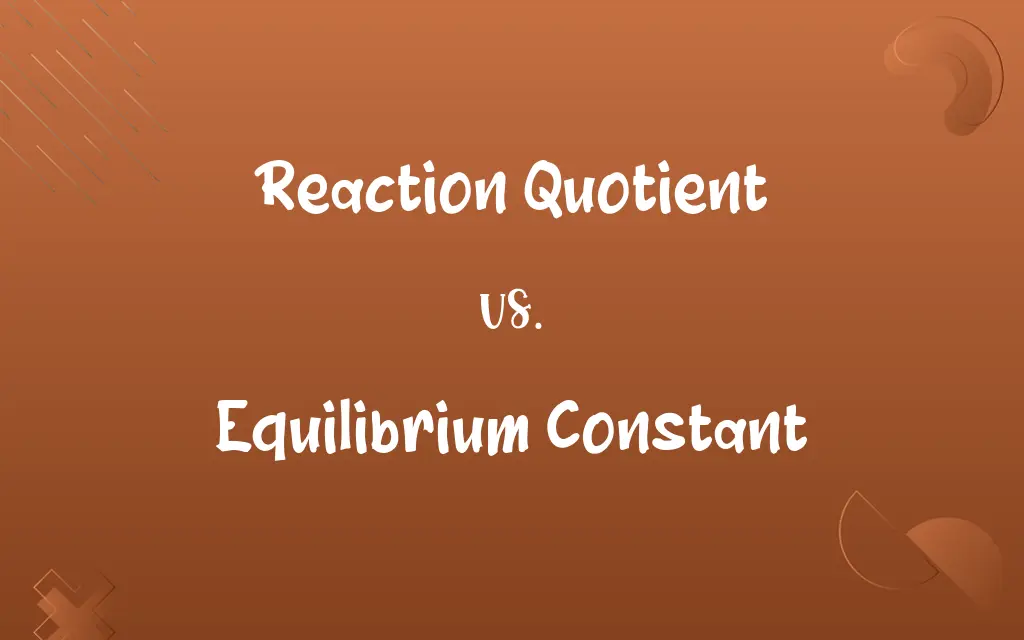Reaction Quotient vs. Equilibrium Constant: Know the Difference

By Shumaila Saeed || Published on January 12, 2024
Reaction Quotient (Q) measures the relative amounts of products and reactants at any point during a reaction, whereas the Equilibrium Constant (K) measures the relative amounts of products and reactants at the state of chemical equilibrium.

Key Differences
Reaction Quotient (Q) is a measure that indicates the direction in which a reaction is proceeding at any given moment. Equilibrium Constant (K), in contrast, is a specific value that signifies the ratio of products to reactants when a reaction has reached its equilibrium state. Both concepts help in understanding the progress of chemical reactions.
Shumaila Saeed
Jan 12, 2024
In the context of a chemical reaction, the Reaction Quotient (Q) changes as the reaction progresses, reflecting the current state of the reaction. The Equilibrium Constant (K) remains constant for a given reaction at a specific temperature, representing the balance point of the reaction. Both are calculated using a similar formula but at different reaction stages.
Shumaila Saeed
Jan 12, 2024
Reaction Quotient (Q) can be greater than, less than, or equal to the Equilibrium Constant (K). When Q equals K, the system is at equilibrium. Understanding both Q and K is crucial for predicting the direction of a chemical reaction and determining its state.
Shumaila Saeed
Jan 12, 2024
The calculation of Reaction Quotient (Q) involves the concentrations of the reactants and products at any stage of the reaction. For the Equilibrium Constant (K), the concentrations used in the calculation are those at equilibrium. Both utilize the same formula structure but are applied under different conditions.
Shumaila Saeed
Jan 12, 2024
Reaction Quotient (Q) helps in predicting the shift in a reaction, whether it will proceed towards products or reactants. Equilibrium Constant (K) indicates the extent to which a reaction proceeds before reaching equilibrium. Both are fundamental in chemical kinetics and thermodynamics.
Shumaila Saeed
Jan 12, 2024
ADVERTISEMENT
Comparison Chart
Definition
Ratio of product and reactant concentrations at any point
Ratio of product and reactant concentrations at equilibrium
Shumaila Saeed
Jan 12, 2024
Value Change
Changes as reaction progresses
Constant for a given reaction at a fixed temperature
Shumaila Saeed
Jan 12, 2024
Predictive Use
Predicts reaction shift direction
Indicates reaction favorability
Shumaila Saeed
Jan 12, 2024
ADVERTISEMENT
Reaction Quotient and Equilibrium Constant Definitions
Reaction Quotient
It represents the current state of a chemical reaction, dynamically changing.
As reactants A and B are used up, the Reaction Quotient changes, indicating the progress of the reaction.
Shumaila Saeed
Dec 16, 2023
Equilibrium Constant
Equilibrium Constant is the ratio of concentrations of products to reactants at chemical equilibrium.
For the reaction A + B ⇌ C, when the reaction reaches equilibrium, the Equilibrium Constant can be calculated from the concentrations.
Shumaila Saeed
Dec 16, 2023
Reaction Quotient
Reaction Quotient is the ratio of concentrations of reaction products to reactants at any point in time.
In a reaction A + B ⇌ C, if the concentration of C increases, the Reaction Quotient increases accordingly.
Shumaila Saeed
Dec 16, 2023
Equilibrium Constant
It indicates the extent to which a reaction proceeds before reaching equilibrium.
A high Equilibrium Constant suggests a reaction largely produces products.
Shumaila Saeed
Dec 16, 2023
Reaction Quotient
Reaction Quotient is used to predict the direction in which a reaction will proceed.
If Q is less than K, the reaction will proceed towards producing more products.
Shumaila Saeed
Dec 16, 2023
ADVERTISEMENT
Equilibrium Constant
It determines the favorability and yield of a chemical reaction at equilibrium.
A reaction with a low Equilibrium Constant favors the reactants at equilibrium.
Shumaila Saeed
Dec 16, 2023
Reaction Quotient
It is a measure of the relative amounts of products and reactants during the reaction process.
A high Reaction Quotient indicates a predominance of products at that specific time.
Shumaila Saeed
Dec 16, 2023
Equilibrium Constant
Equilibrium Constant is fundamental in predicting the outcome of a chemical reaction.
Knowing the Equilibrium Constant helps chemists understand how likely a reaction is to produce a significant amount of products.
Shumaila Saeed
Dec 16, 2023
Reaction Quotient
Reaction Quotient helps in understanding the shift of a reaction away from equilibrium.
When Q differs significantly from K, it suggests the reaction is far from reaching equilibrium.
Shumaila Saeed
Dec 16, 2023
Equilibrium Constant
Equilibrium Constant is a constant value for a given reaction at a specific temperature.
If the temperature remains constant, the Equilibrium Constant for a reaction does not change.
Shumaila Saeed
Dec 16, 2023
Repeatedly Asked Queries
How is the Reaction Quotient used in chemical analysis?
It is used to determine the current state and direction of a reaction.
Shumaila Saeed
Jan 12, 2024
How is the Equilibrium Constant different from the Reaction Quotient?
The Equilibrium Constant is a specific value indicating the ratio of products to reactants at equilibrium, unlike the Reaction Quotient, which changes as the reaction progresses.
Shumaila Saeed
Jan 12, 2024
What is the Reaction Quotient?
It's a measure of the ratio of product and reactant concentrations at any point during a chemical reaction.
Shumaila Saeed
Jan 12, 2024
What happens when the Reaction Quotient equals the Equilibrium Constant?
The reaction is at equilibrium when Q equals K.
Shumaila Saeed
Jan 12, 2024
Can the Reaction Quotient predict the direction of a reaction?
Yes, it helps predict whether a reaction will proceed towards products or reactants based on its value relative to the Equilibrium Constant.
Shumaila Saeed
Jan 12, 2024
Is the Equilibrium Constant always the same for a reaction?
Yes, it remains constant for a given reaction at a specific temperature.
Shumaila Saeed
Jan 12, 2024
Does the Equilibrium Constant indicate reaction speed?
No, it indicates the extent of a reaction at equilibrium, not its speed.
Shumaila Saeed
Jan 12, 2024
Is the Equilibrium Constant applicable only at equilibrium?
Yes, it defines the ratio of products to reactants specifically at equilibrium.
Shumaila Saeed
Jan 12, 2024
What does a high Reaction Quotient indicate?
A high Q suggests a predominance of products at a given point in the reaction.
Shumaila Saeed
Jan 12, 2024
What does a low Equilibrium Constant mean?
A low K value indicates a reaction that favors the formation of reactants.
Shumaila Saeed
Jan 12, 2024
How are the values of Q and K calculated?
Both are calculated using the ratio of product concentrations to reactant concentrations, but at different stages of the reaction.
Shumaila Saeed
Jan 12, 2024
Is the Equilibrium Constant affected by concentration changes?
No, it remains constant despite changes in concentrations of reactants or products.
Shumaila Saeed
Jan 12, 2024
How does temperature affect the Equilibrium Constant?
The value of K can change with temperature, as it is temperature-dependent.
Shumaila Saeed
Jan 12, 2024
Can the Reaction Quotient be greater than the Equilibrium Constant?
Yes, if Q is greater than K, the reaction tends to form more reactants.
Shumaila Saeed
Jan 12, 2024
Can the Reaction Quotient be used for reactions in any phase?
Yes, it applies to gaseous, liquid, and even solid-phase reactions.
Shumaila Saeed
Jan 12, 2024
Is the Equilibrium Constant related to reaction spontaneity?
Yes, it can indicate whether a reaction is thermodynamically favorable.
Shumaila Saeed
Jan 12, 2024
How is the Equilibrium Constant useful in industrial chemical processes?
It helps in designing processes for optimal yield of products.
Shumaila Saeed
Jan 12, 2024
Can a reaction have multiple Equilibrium Constants?
No, each reaction has one unique Equilibrium Constant at a given temperature.
Shumaila Saeed
Jan 12, 2024
How does the Reaction Quotient help in adjusting reactions?
It helps in determining how to adjust conditions to shift the reaction towards equilibrium.
Shumaila Saeed
Jan 12, 2024
What role does the Reaction Quotient play in dynamic equilibrium?
It indicates how far the system is from reaching equilibrium.
Shumaila Saeed
Jan 12, 2024
Share this page
Link for your blog / website
HTML
Link to share via messenger
About Author
Written by
Shumaila SaeedShumaila Saeed, an expert content creator with 6 years of experience, specializes in distilling complex topics into easily digestible comparisons, shining a light on the nuances that both inform and educate readers with clarity and accuracy.








































































